Greek alphabet (Ελληνικό αλφάβητο)
Origin
The Greek alphabet has been in continuous use for the past 2,750 years or so since about 750 BC. It was developed from the Canaanite/Phoenician alphabet and the order and names of the letters are derived from Phoenician. The original Canaanite meanings of the letter names was lost when the alphabet was adapted for Greek. For example, alpha comes for the Canaanite aleph (ox) and beta from beth (house).At first, there were a number of different versions of the alphabet used in various different Greek cities. These local alphabets, known as epichoric, can be divided into three groups: green, blue and red. The blue group developed into the modern Greek alphabet, while the red group developed into the Etruscan alphabet, other alphabets of ancient Italy and eventually the Latin alphabet.
By the early 4th century BC, the epichoric alphabets were replaced by the eastern Ionic alphabet. The capital letters of the modern Greek alphabet are almost identical to those of the Ionic alphabet. The minuscule or lower case letters first appeared sometime after 800 AD and developed from the Byzantine minuscule script, which developed from cursive writing.
Notable features
- Type of writing system: alphabet - the first one to include vowels.
- Direction of writing: Originally written horizontal lines either from right to left or alternating from right to left and left to right (boustrophedon/βουστροφηδόν). Around 500 BC the direction of writing changed to horizontal lines running from left to right.
- Diacritics to represent stress and breathings were added to the alphabet in around 200 BC. In 1982 the diacritics representing breathings, which were not widely used after 1976, were officially abolished by presidential decree.
- The letter sigma has a special form which is used when it appears at the end of a word.
Used to write
Greek (Ελληνικά), an Indo-European language spoken by about 14 million people mainly in Greece and Cyprus, where it is an official language. Greek is also recognised as a minority language in parts of Turkey, Italy and Albania.Today the Greek alphabet is used only to write Greek, however at various times in the past it has been used to write such languages as Lydian, Phrygian, Thracian, Gaulish, Hebrew, Arabic, Old Ossetic, Albanian, Turkish, Aromanian, Gagauz, Surguch and Urum.
Ancient Greek alphabet
This alphabet is based on inscriptions from Crete dated to about 800 BC. Greek was written from right to left in horizontal lines at this time. The names of the letters were slightly different to those for later varities Greek.
Greek alphabet (Classical Attic pronunciation)
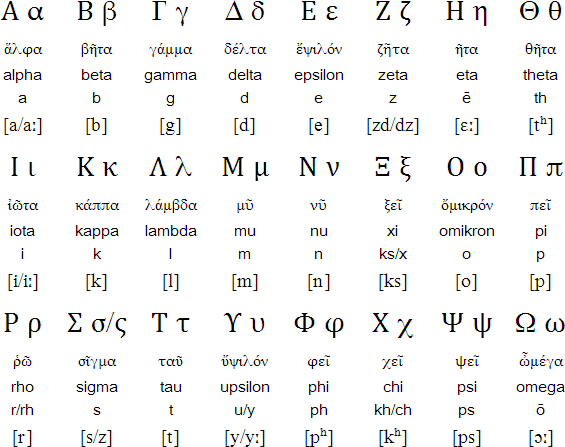
Note
- Σ = [z] before voiced consonants
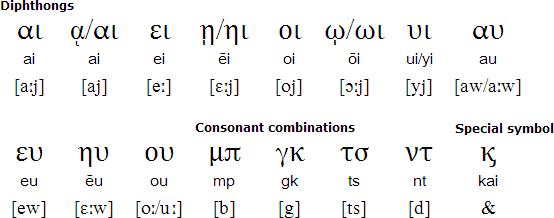
Obsolete and archaic letters
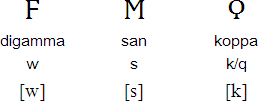
Greek numerals and other symbols
The Ancient Greeks had two numeric systems: the Acrophonic or Attic system used the letters iota, delta, gamma, eta, nu and mu in various combinations. These letters were used as they represented the first letters of the number names, with the exception of iota: Γέντε (gente) for 5, which became Πέντε (pente); Δέκα (Deka) for 10, Ηἑκατόν (Hektaton) for 100, Χίλιοι (Khilioi) for 1,000 and Μύριον (Myrion) for 10,000. This system was used until the first century BC.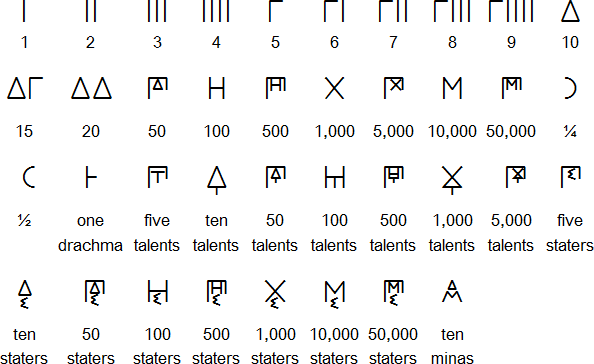
The Acrophonic system was replaced by an alphabetic system that assigned numerical values to all the letters of the alphabet. Three obsolete letters, stigma, koppa and sampi, were used in addition to the standard Greek letters, and a apostrophe-like numeral sign was used to indicate that letters were being used as numerals.
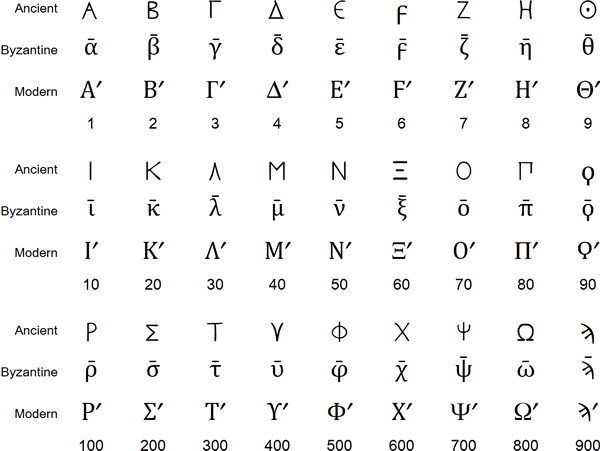
Greek alphabet (Modern pronunciation)
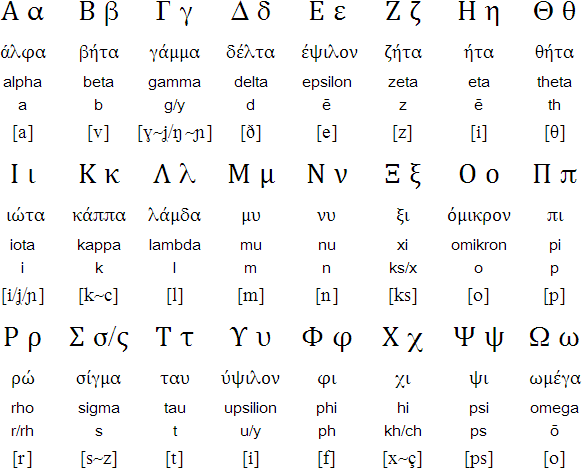
Downloads
Download a Greek alphabet chart in Word or PDF format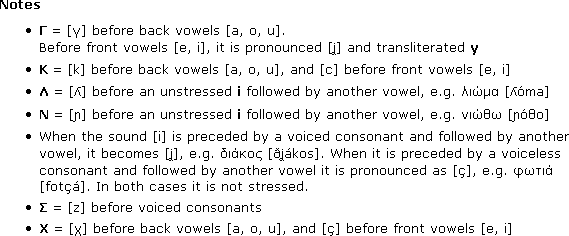
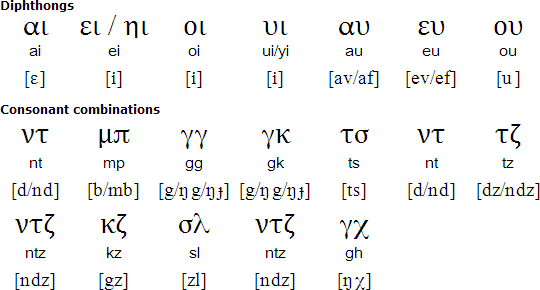
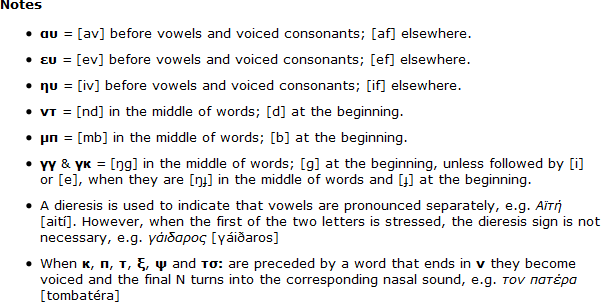
Sample text in Greek

Transliteration
Óli i ánthropi yeniúnde eléftheri ke ísi stin aksioprépia ke ta dhikeómata. Íne prikizméni me loyikí ke sinídhisi, ke ofílun na simberiféronde metaksí tus me pnévma adhelfosínis.A recording of this text by Eυτυχία Παναγιώτου (Eftychia Panayiotou)
Sample text in Polytonic Greek

Sample text in handwritten Greek

Font from: http://boboss.gr/2009/12/13/greek-handwriting-font/
Translation
All human beings are born free and equal in dignity and rights. They are endowed with reason and conscience and should act towards one another in a spirit of brotherhood.(Article 1 of the Universal Declaration of Human Rights)
Links
Information about the Greek languagehttp://en.wikipedia.org/wiki/Greek_language
http://greek-language.com
Information about Greek numbering systems
http://www-history.mcs.st-and.ac.uk/HistTopics/Greek_numbers.html
http://en.wikipedia.org/wiki/Greek_numerals
http://en.wikipedia.org/wiki/Attic_numerals
http://www.mathsisgoodforyou.com/numerals/greeknums.htm
Online Greek lessons
http://www.kypros.org/LearnGreek/ (Modern/Ancient)
http://www.ilearngreek.com (Modern)
http://www.greece.org/gr-lessons/ (Modern)
http://www.xanthi.ilsp.gr/filog/ (Modern)
http://en.wikibooks.org/wiki/Modern_Greek (Modern)
http://greekthrumusic.blogspot.com/ (Modern)
http://www.ibiblio.org/koine/greek/lessons/ (New Testament)
http://socrates.berkeley.edu/~ancgreek/ (Ancient)
http://www.textkit.com (Ancient)









.jpg)
.jpg)

.jpg)





0 comments:
Post a Comment
Note: Only a member of this blog may post a comment.